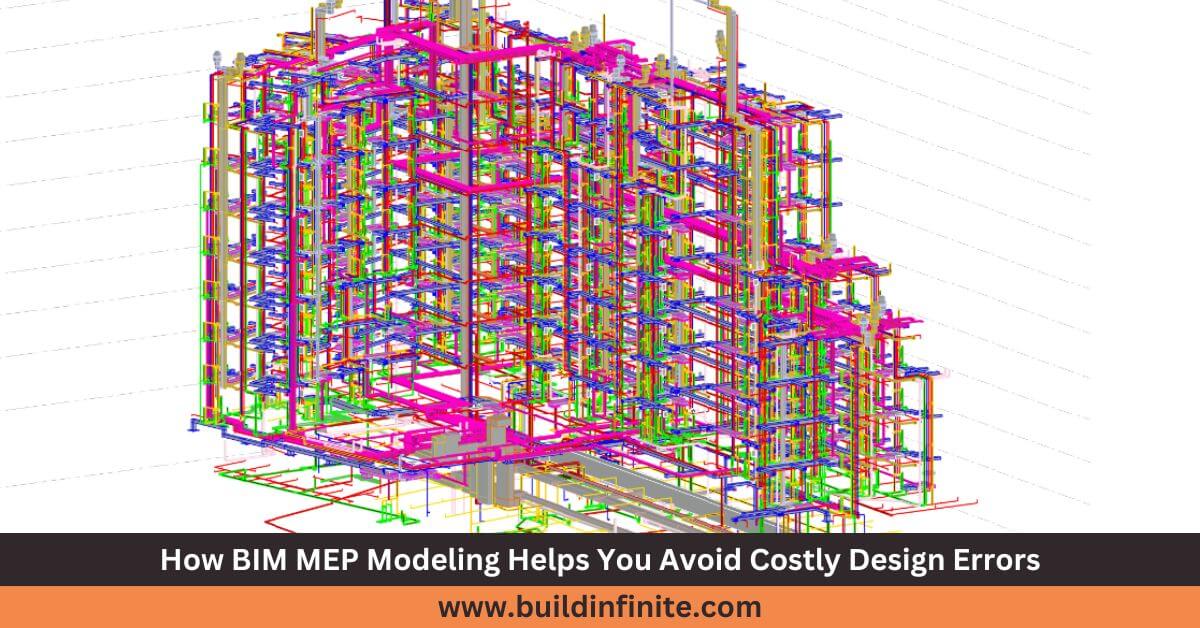In the world of construction and design, accuracy and precision are paramount. When designing mechanical, electrical, and plumbing (MEP) systems, even a minor error can lead to costly delays, unexpected expenses, and even safety hazards.
Fortunately, Building Information Modeling (BIM) for MEP design has become a powerful tool that helps professionals avoid costly design errors, ensuring smoother project execution and more efficient building systems.
In this blog post, we’ll explore how BIM MEP Modeling can help you avoid costly design errors, enhance collaboration, reduce rework, and improve overall project outcomes. Whether you’re a contractor, engineer, or architect, understanding the benefits of BIM MEP modeling is essential to staying competitive in the construction industry.
What is BIM MEP Modeling?
BIM MEP modeling refers to the use of BIM technology to design, visualize, and simulate the mechanical, electrical, and plumbing systems within a building.
It integrates the MEP components into a single 3D digital model, providing a detailed and accurate representation of the building systems.
Unlike traditional 2D drawings, which only represent the layout of systems without showing how they interact, BIM MEP models offer a more holistic view. They enable designers and contractors to visualize and analyze how various MEP components work together, allowing for better coordination and fewer errors during construction.
1. Improved Collaboration and Coordination
One of the primary benefits of BIM MEP modeling is its ability to improve collaboration among project stakeholders, including Architects, Engineers, Contractors, and Subcontractors.
When all parties work from the same digital model, everyone can see and understand how the MEP systems fit within the building design.
In traditional design processes, MEP systems are often developed separately from the building architecture, leading to the risk of conflicts between systems or with the structure itself.
For instance, a poorly placed ductwork system may interfere with the ceiling layout or plumbing pipes might clash with structural beams.
BIM MEP modeling helps identify these issues early on by creating a detailed, 3D representation of the building and its systems. This allows all team members to spot potential clashes or conflicts before they become problems on-site, reducing the need for costly changes during construction.
By providing a platform for real-time collaboration, BIM MEP modeling ensures that everyone involved in the project is on the same page, which is essential for avoiding design errors and costly revisions.
2. Clash Detection and Resolution
Clash detection is one of the most powerful features of BIM MEP modeling. When multiple building systems – such as HVAC ducts, electrical conduits, and plumbing pipes—are designed independently, there’s a high likelihood of clashes or conflicts occurring when the systems are installed.
BIM MEP models incorporate advanced clash detection tools that automatically check for potential conflicts between systems. These tools highlight any clashes, such as when a ductwork system intersects with a structural beam or when pipes run through a wall where they shouldn’t.
By detecting these issues early, designers can resolve them in the digital model, preventing costly rework on-site.
Clash detection also allows for more efficient scheduling. By knowing where potential conflicts lie, the team can adjust the installation schedule to avoid delays, making the entire process smoother and more predictable.
3. Accurate and Detailed Design
With BIM MEP modeling, the level of detail and accuracy far surpasses traditional 2D design methods. Every component, from HVAC systems to electrical outlets, is accurately modeled and integrated into the digital representation of the building.
This high level of accuracy helps to avoid errors such as under-sized equipment, inaccurate pipe lengths, or poorly positioned electrical systems. In traditional 2D designs, these issues may not become apparent until construction is underway, leading to expensive design changes and delays.
Additionally, BIM MEP models are parametric, meaning that if one component is adjusted, the entire system is updated automatically.
For example, if a change in the building design requires resizing a duct, the BIM model will automatically adjust the rest of the systems to accommodate the new dimensions. This eliminates manual adjustments and helps maintain the integrity of the entire design, ensuring no components are overlooked or miscalculated.
4. Simulations and Energy Analysis
BIM MEP modeling allows for detailed simulations of how MEP systems will perform in the building once it’s complete. This includes energy analysis, which helps identify inefficiencies in the building’s systems, such as heating, ventilation, air conditioning (HVAC), and lighting.
By simulating the performance of these systems, BIM MEP modeling helps ensure that they are optimized for energy efficiency and cost-effectiveness. Energy analysis can identify design flaws that could lead to higher operating costs, such as oversized HVAC units, inefficient lighting layouts, or poor insulation.
Addressing these issues during the design phase, rather than after construction has begun, can save significant amounts of money in energy bills and help ensure compliance with local building codes and environmental regulations.
Also Read, Plumbing Shop Drawings for Builders
5. Reduced Risk of Change Orders
Change orders are a common issue in traditional construction projects, often resulting in delays, budget overruns, and frustration among project stakeholders.
They occur when unforeseen problems arise during construction that require modifications to the original design, such as structural changes, material substitutions, or adjustments to MEP systems.
BIM MEP modeling helps reduce the likelihood of change orders by allowing for comprehensive design review and approval before construction begins.
With a 3D model of the building and its systems, all project stakeholders can review the design thoroughly, identify potential problems, and make adjustments prior to construction.
In addition, because BIM MEP models are highly accurate, there’s less chance that unforeseen issues will arise during construction. This leads to fewer change orders, reducing project delays and unexpected costs.
6. Efficient Project Scheduling and Cost Estimation
BIM MEP modeling not only improves design accuracy but also helps with project scheduling and cost estimation. The digital model contains all the information needed to estimate material quantities, labour requirements, and overall project costs.
With BIM MEP modeling, contractors can generate accurate, real-time cost estimates based on the digital model. This reduces the risk of underestimating costs, which can lead to financial issues and project delays.
It also provides a more transparent view of the budget, allowing stakeholders to make informed decisions throughout the project. BIM models also support project scheduling by identifying dependencies between different tasks and systems.
For example, electrical wiring might need to be installed before drywall is placed, and plumbing might need to be completed before flooring is finished. The BIM model helps optimize the sequence of these tasks, reducing delays and ensuring that each phase of the project flows smoothly.
7. Enhanced Facility Management and Maintenance
BIM MEP models aren’t just useful during the design and construction phases—they can also help facility managers maintain building systems after construction is complete.
Once the building is operational, the BIM model serves as a digital record of the MEP systems, making it easier for facility managers to locate equipment, understand system specifications, and plan for maintenance or upgrades.
Having accurate, up-to-date information about the building’s systems reduces the risk of errors during maintenance and repairs.
For example, suppose an HVAC unit needs to be replaced. In that case, the BIM model can provide detailed information about the unit’s specifications and location, ensuring the correct replacement part is ordered and installed.
Conclusion
In conclusion, BIM MEP modeling is a powerful tool that helps avoid costly design errors by improving collaboration, enhancing design accuracy, detecting clashes, and optimizing performance.
It empowers project teams to identify potential issues before they escalate, reducing the risk of delays, rework, and change orders. BIM MEP modeling also provides invaluable support for project scheduling, cost estimation, and long-term facility management.
For anyone involved in MEP design or construction, adopting BIM MEP modeling is no longer optional – it is a necessary step toward improving efficiency, reducing costs, and delivering higher-quality buildings. Whether you’re designing a new building or renovating an existing structure, BIM MEP modeling is your best defense against costly design errors.



